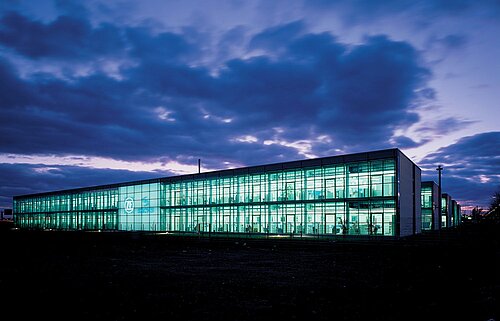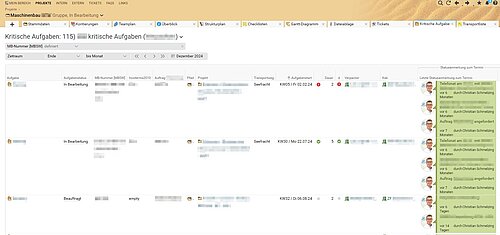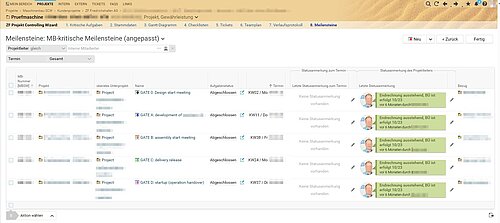A model of the reality of our organisation and working methods
Success story from ZF Friedrichshafen AG
ZF Maschinenbau (Zahnradfabrik Friedrichshafen) develops and builds special machines and tools for internal customers and delivers them to the worldwide locations of ZF Friedrichshafen AG. Every year, around 900 processes are created as BCS projects. This includes around 70 projects for special machines. With Projektron BCS, not only can they be mapped precisely, we have also noticeably increased the efficiency and effectiveness of our project work.
ZF Friedrichshafen AG is one of the global market leaders in driveline and chassis technology and one of the largest automotive suppliers. The company was founded in 1915, the abbreviation in its name stands for Zahnradfabrik (gear factory). Today, ZF employs over 153,500 people at approx. 270 locations in 42 countries. ZF's customers include all well-known original equipment manufacturers in the automotive industry and vehicle manufacturers such as Porsche, BMW, Audi and Daimler, as well as motorbike manufacturers such as Ducati. It can be said that almost everything that moves with four - or two - wheels contains technology from ZF. For example, the hybrid drive of the Porsche 918 Spyder comes from ZF Friedrichshafen.
ZF Mechanical Engineering is a strategic partner to all ZF divisions and develops, builds and supplies special machines for internal use. In this way, we make a decisive contribution to the process development and industrialisation of various innovative ZF products. Every year, we prepare around 900 quotations for spare parts, tools and special machine developments. This results in around 70 projects for special machines at ZF Maschinenbau every year. These vary greatly in scope, typically lasting between 9 and 14 months. All projects are carried out across divisions, and our customers always come from other divisions and from ZF Friedrichshafen AG locations worldwide. ZF Mechanical Engineering generated sales of around 33 million euros in 2015.
Initial situation, requirements and selection process
Until 2015, project management at ZF Maschinenbau was based on a static data model in Microsoft Access and Excel. Some of our projects are highly complex, which meant that they could not be coordinated with the previous solution. In addition, we lacked the options for multi-project analyses and monitoring across all projects; we wanted more transparency. We were also faced with the question of what project management would look like in 10 years' time if we continued to use the existing tools.
So we started researching the market - first on the Internet and later at CeBIT. There we also got to know Projektron and included BCS in the software evaluation. In addition to the PMO and the IT department, our purchasing department and the works council were also involved in the concrete requirements analysis in order to jointly determine the most suitable tool. The final selection included Microsoft Project Server, the SAP PS and Projektron BCS already available in the Group, which ultimately led to the decision. We were particularly impressed by the software's ergonomics, which we expected to be highly accepted by users, as well as the browser-based approach, thanks to which local installation at individual workstations is no longer necessary. The options for individual customisation also played a role in the decision, as BCS allows us to map our own organisation without having to make any compromises.
Use of Projektron BCS
We started installing Projektron BCS in March 2015. Projects planned up to that point were still being processed in the old form; we created all new projects directly in BCS. We deliberately avoided fixed interfaces to other systems in order to ensure the consolidation of the application and provided users with the necessary knowledge through training. Key users were specifically trained at Projektron, and all project managers and employees who perform account assignment in BCS also received in-house training with a customised training manual.
The broad acceptance of users was achieved and maintained through our project marketing in the context of regular information events. After the works council authorised the use of Projektron BCS at the Schweinfurt site in January 2016, around 70 to 80 of our 120 employees from the development, procurement, production and assembly departments are now working with BCS in various user roles. We primarily use the project planning, resource management, project controlling and time recording functions as well as the ticket system in BCS. Interfaces only exist for the exchange with external service providers via normal export/import processes. For example, we use the file repository to manage specification and verification documents for our projects.
We have highly standardised the procedure for creating our offers and often work with our own project templates. This has the advantage that we don't have to have to start from scratch. Enquiries are collected centrally. Programme managers create the master data as a project with enquiry status and assign a project manager. The customer then receives an e-mail generated from BCS as an enquiry confirmation. The project manager is then requested to create a quotation within a certain period of time and also send this via BCS. When the customer commissions the project, the effort and structure planning begins with a fixed end date. After commissioning, the project manager plans the tasks and deadlines bottom-up and documents the progress of the project in BCS for the duration of the project. Checklists help to fulfil the quality assurance requirements.
After the project is completed, the findings are incorporated into the templates as lessons learnt and complete them with the effect that they become increasingly error-proof.
In regular project controlling meetings, the milestone meetings, the project managers report on their respective projects with the aim of releasing milestones. We also access BCS for this and use our own assistant for our project controlling. We have created our own dashboard for this purpose. Completed projects remain documented in BCS, so that they can be allocated in the event of subsequent enquiries and post-calculation is also possible thanks to the true-to-effort account assignment.
Conclusion
BCS has become a model of the reality of our organisation and working methods. In addition to the high degree of standardisation thanks to the new approach with BCS, we particularly appreciate the fact that we can access real-time data and that our project data is always up to date despite the great complexity.
With BCS, we are now able to provide information to customers at the touch of a button. In addition, deputy functions can be performed more easily because all information is accessible, search efforts have been dramatically reduced and transparency finally prevails. As a learning organisation, we have also increased the efficiency and effectiveness of our project work. In future, Projektron BCS will be used by other business units, such as ZF Race Engineering. If necessary, we will also introduce further interfaces in order to avoid duplicate data storage and further increase efficiency. Together with customers, we also want to utilise the ticket system even more intensively, possibly in several languages. We will continue to have minor adjustments made by Projektron's support team. In our experience, the cooperation with Projektron works very well and technical issues are brought to a successful conclusion together. The business relationship with Projektron can be described as a win-win situation.













